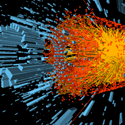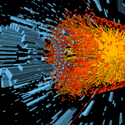Bringing nuclei together breaks quarks apart
Smashing together lone particles, such as protons, shows experimenters what other particles can be assembled using the collision energy. But smashing together nuclei containing hundreds of protons and neutrons creates a hot, dense state that is like a fluid. Understanding this state gives a window into the properties of the early universe.
Ordinarily, quarks cannot roam freely, but are bound in groups of two or three to form mesons and baryons. Theorists predict that above about two trillion degrees, quarks, and the gluons that bind them, will break apart and form a new state called the quark-gluon plasma (QGP). These conditions exist for a tiny fraction of a second after large nuclei collide in particle accelerators, most recently at the Large Hadron Collider (LHC).
Researchers analyze the fragments from these collisions in various ways to learn about the new state. One important clue is how efficiently the collision produces heavy mesons, because the QGP is expected to screen the binding of these quark-antiquark pairs, causing them to fall apart even faster than usual.
In Physical Review Letters, the Compact Muon Solenoid (CMS) team at the LHC looks at the upsilon meson, a bound bottom quark and its antiquark. In collisions between lead nuclei, they find that a significantly smaller fraction of these particles occur in the excited state, compared to the fraction for collisions between protons. They surmise that the excited states are more sensitive to the screening, as expected from models of the QGP. – Don Monroe





